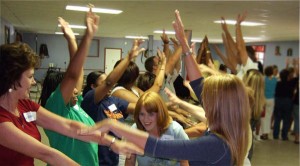
Having an effective employee team building day falls on the shoulders of the facilitator, but also the participants. Of course the participants are the real key, but if brainstorming and cooperation among participants is not realized, there is zero chance for success.
By preparing for the day and then leveraging the roles of both the facilitator and the participants, team building transcends to a whole new level. Employees walk away from the day with a new sense of group cohesiveness and real buy-in to the decisions formulated throughout the day’s activities.
10 Team Building Day Tips
Before the day arrives, make sure to follow these 10 tips to set yourself up for an outstanding team building day:
- Choose an off-site facility away from work. Participants must be taken outside the day-to-day work environment in order to get the problem-solving “juices” flowing.
- Establish a penalty-free zone. Make sure the participants challenge by choice, know their right to pass, and that their input can be confidential, if needed.
- Consider safety at all time for the participants. This includes both physical and emotional safety (see tip #2 in regard to confidentiality!).
- Account for lots and lots of breaks. This will keep people from mentally “checking out” throughout the day.
- Incorporate a variety of presentation styles to reach all types of learners. This will ensure different learning styles (auditory, visual, kinesthetic) are being accounted for in order to reach all participants. If someone needs to physically see something in order to understand a point, (i.e. a chart representing the makeup of customers for the company when demonstrating the need to reach more demographics) make sure a visual aide is there for the visual learner.
- Occasionally divide into sub-groups. Small groups of people foster maximum involvement, no question.
- Get up and move around. Change seat assignments and go outside (if possible) to account for the undeniable fact that human attention spans are short!
- Summarize what has been learned throughout the day. Don’t wait for the end of the day to sum up what was achieved. Make time for reflection and de-brief time after activities to allow participants to share what was learned when it is still fresh in their minds.
- Fun, fun, fun! Incorporate team building games for work. When the day is complete, participants should go away feeling accomplished and happy. No one should dread a team building day!
- End on time. Unfortunately “going over” has become the norm. Make a promise to end on time, then do it!
Process vs. Product
Once the logistics of the team building day is in place, make sure the roles of facilitator and participant are being executed correctly.
The “process” is the responsibility of the facilitator
The “product” is the responsibility of the group.
The main task of the facilitator is to help the group increase its effectiveness by improving its process.
The fundamental assumption of the facilitator is this:
If we can improve group process, we can improve the group’s ability to solve problems and make decisions.
I think facilitators, particularly new ones, get hung up sometimes thinking that they are responsible for the outcome of a group’s efforts. If you are operating as a true facilitator, your job starts and ends with the development and maintenance of a healthy facilitative process appropriate to the product the group desires. Process refers to how a group works together. Their product could be the solution to a problem, a plan of action, a deeper more effective working relationship between group members, etc. But whatever their product, the group is responsible for delivering it, not you.
In fact, if a facilitator is an expert in the group’s content, he or she must guard against the temptation to intervene in that content. This might distract the group process and negate the facilitator’s all important neutrality.
For example, suppose you are facilitation a group that is interested in improving customer service. Discussions around creating and implementing ideas to get more feedback from customers, improving the relating skills of front-line employees, improving systems to provide faster more efficient service, etc. are all discussions about content.
Facilitator Maximizes Participation
As a facilitator your job is to listen. When you really listen you can pick up on HOW group members are relating and working together. It’s very powerful stuff when you really listen and observe the group during the conversation.
During the exchange, you might notice that some group members:
- Give answers without acknowledging others
- Talk over others without listening to their input
- Misinterpret what is being said by another
- Provide input through their body language only
Once these behaviors are noted, you as a facilitator can intervene to improve group process to improve their communication process, problem-solving process, and decision-making process, etc. You can also serve as an advocate for an individual who is being left-out of the process altogether by making sure they are not being discounted by the group. By listening and acting on what is heard, the facilitator can step in where needed to maximize group participation.
What is team building after all, but a way for the entire group to engage in a result-oriented process to solve problems and make decisions. So next time you are involved in a meeting, observe and distinguish between elements of the meeting that are content or process. Make sure that you adhere to the role you are there to fill, be it facilitator or participant. You’ll be surprised how worthwhile a meeting can be!
Maximize Your Team Building Day with Larry Lipman
Larry is a Team Building Specialist who success coaches participants into powerful, cohesive TEAMS. He can help engage your team to reach real results and achieve participant buy-in for new ideas and solutions. Call Larry today at 770-333-3303 and find out for yourself how powerful teamwork games can be!






